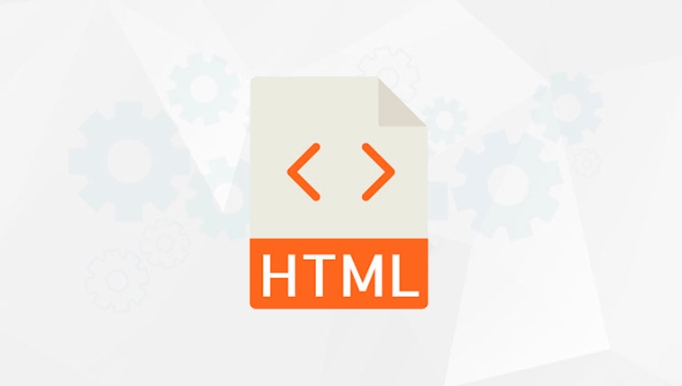Structuring Content Using Unordered and Ordered Lists in HTML
Jul 09, 2025 am 12:05 AMUnordered lists are suitable for items without a specific order, and are wrapped with
<ul> tags, and each entry is represented by <li>; an ordered list is used for content with order requirements, and is wrapped with <ol> tags, and each entry is also represented by <li>. 1. Unordered lists use dots as marking symbols by default, and are often used in scenarios such as website navigation menus, article labels or product feature introductions. 2. The ordered list is displayed in sequence through numbering, suitable for operation steps, competition rankings or teaching processes, and the numbering style can be defined through type attributes. 3. Lists can be used in nesting, and they can be included in each other, but you need to pay attention to issues such as indentation, hierarchy, and semantics to improve readability and SEO effect.
In web development, lists are one of the most common ways to organize information. HTML provides two basic list structures: unordered list and ordered list. They not only improve the readability of the page, but also help search engines better understand content structure.

What are unordered and ordered lists?
Unordered lists are suitable for items without a specific order, such as shopping lists, hobbies, etc., and are wrapped with <ul></ul> tags, and each entry is represented by <li> .

Ordered lists are used for content with order requirements, such as step instructions, rankings, etc., and are wrapped with <ol></ol> tags, and each entry is also represented by <li> .
For example:
 <ul>
<li>
<ul>
<li>
Unordered list:
<ul> <li> bread <li> milk <li> egg <li>Ordered list:
<ol> <li> Open a browser <li> Enter the URL <li> Press EnterBoth lists can be used in nesting to build more complex structures, such as menu navigation or multi-level task listings.
How to use unordered lists correctly?
When there is no order between the content items you list, you should use an unordered list. It uses dots as marker by default, but can also be customized with CSS.
Common usage scenarios include:
<ul> <li> Website navigation menu <li> Article tags or keywords <li> Product Features Introduction The writing method is very simple, you only need to wrap multiple <li> in one <ul></ul> :
<ul> <li>Home </li> <li>About Us</li> <li>Contact Us</li> </ul>
If you want the list to look more beautiful, you can use images, icons, or custom colors to replace the default dots with CSS.
When should I use an ordered list?
When your content needs to be displayed in order, such as operational steps, competition rankings, teaching processes, etc., an ordered list should be used.
For example, the steps to make a cake:
<ol><li> Prepare materials<li> Mix flour and eggs<li> Pour into the mold<li> Put in the oven to bakeIts HTML structure is also very straightforward:
<ol> <li>Preparation of materials</li> <li>Mix flour and eggs</li> <li>Pour into mold</li> <li>Put in the oven to bake</li> </ol>
You can also change the numbering style through type attribute, such as using letters or Roman numerals:
type="A" : capital letters<li> type="a" : lowercase letters<li> type="I" : capital Roman numeral<li> type="i" : lowercase Roman numeralThis allows you to choose the appropriate numbering method according to the content style.
List nesting and notes
Sometimes we need to include another list in one list item, which requires the use of nested structure. Whether it is <ul> or <ol> , it can be nested with each other.
For example, a menu may have first-level classification and sub-category:
<ul>
<li>Home </li>
<li>Products<ul>
<li>Mobile phone</li>
<li>Computer</li>
<li>Accessories</li>
</ul>
</li>
<li>Service</li>
</ul>The following points should be paid attention to when nesting:
<ul> <li> The internal list should be indented to facilitate reading of the source code <li> Each<li> can contain only one sublist unless you explicitly want multiple block-level elements to be displayed in parallel
<li> Do not over-neck, as above three layers will reduce maintainability and readability
In addition, semantics are also important. Using the right tags not only helps SEO, but also helps screen readers identify content structures.
Basically that's it. Mastering the use of disordered and ordered lists can make your web page content more organized and easier to be understood by users and crawled by search engines.
The above is the detailed content of Structuring Content Using Unordered and Ordered Lists in HTML. For more information, please follow other related articles on the PHP Chinese website!

Hot AI Tools

Undress AI Tool
Undress images for free

Undresser.AI Undress
AI-powered app for creating realistic nude photos

AI Clothes Remover
Online AI tool for removing clothes from photos.

Clothoff.io
AI clothes remover

Video Face Swap
Swap faces in any video effortlessly with our completely free AI face swap tool!

Hot Article

Hot Tools

Notepad++7.3.1
Easy-to-use and free code editor

SublimeText3 Chinese version
Chinese version, very easy to use

Zend Studio 13.0.1
Powerful PHP integrated development environment

Dreamweaver CS6
Visual web development tools

SublimeText3 Mac version
God-level code editing software (SublimeText3)

Hot Topics
 How do I embed PHP code in an HTML file?
Jun 22, 2025 am 01:00 AM
How do I embed PHP code in an HTML file?
Jun 22, 2025 am 01:00 AM
You can embed PHP code into HTML files, but make sure that the file has an extension of .php so that the server can parse it correctly. Use standard tags to wrap PHP code, insert dynamic content anywhere in HTML. In addition, you can switch PHP and HTML multiple times in the same file to realize dynamic functions such as conditional rendering. Be sure to pay attention to the server configuration and syntax correctness to avoid problems caused by short labels, quotation mark errors or omitted end labels.
 How do I minimize the size of HTML files?
Jun 24, 2025 am 12:53 AM
How do I minimize the size of HTML files?
Jun 24, 2025 am 12:53 AM
To reduce the size of HTML files, you need to clean up redundant code, compress content, and optimize structure. 1. Delete unused tags, comments and extra blanks to reduce volume; 2. Move inline CSS and JavaScript to external files and merge multiple scripts or style blocks; 3. Simplify label syntax without affecting parsing, such as omitting optional closed tags or using short attributes; 4. After cleaning, enable server-side compression technologies such as Gzip or Brotli to further reduce the transmission volume. These steps can significantly improve page loading performance without sacrificing functionality.
 How has HTML evolved over time, and what are the key milestones in its history?
Jun 24, 2025 am 12:54 AM
How has HTML evolved over time, and what are the key milestones in its history?
Jun 24, 2025 am 12:54 AM
HTMLhasevolvedsignificantlysinceitscreationtomeetthegrowingdemandsofwebdevelopersandusers.Initiallyasimplemarkuplanguageforsharingdocuments,ithasundergonemajorupdates,includingHTML2.0,whichintroducedforms;HTML3.x,whichaddedvisualenhancementsandlayout
 What is the declaration, and what does it do?
Jun 24, 2025 am 12:57 AM
What is the declaration, and what does it do?
Jun 24, 2025 am 12:57 AM
Adeclarationisaformalstatementthatsomethingistrue,official,orrequired,usedtoclearlydefineorannounceanintent,fact,orrule.Itplaysakeyroleinprogrammingbydefiningvariablesandfunctions,inlegalcontextsbyreportingfactsunderoath,andindailylifebymakingintenti
 How do I use the element to represent the footer of a document or section?
Jun 25, 2025 am 12:57 AM
How do I use the element to represent the footer of a document or section?
Jun 25, 2025 am 12:57 AM
It is a semantic tag used in HTML5 to define the bottom of the page or content block, usually including copyright information, contact information or navigation links; it can be placed at the bottom of the page or nested in, etc. tags as the end of the block; when using it, you should pay attention to avoid repeated abuse and irrelevant content.
 How do I use the tabindex attribute to control the tab order of elements?
Jun 24, 2025 am 12:56 AM
How do I use the tabindex attribute to control the tab order of elements?
Jun 24, 2025 am 12:56 AM
ThetabindexattributecontrolshowelementsreceivefocusviatheTabkey,withthreemainvalues:tabindex="0"addsanelementtothenaturaltaborder,tabindex="-1"allowsprogrammaticfocusonly,andtabindex="n"(positivenumber)setsacustomtabbing
 What is the purpose of the input type='range'?
Jun 23, 2025 am 12:17 AM
What is the purpose of the input type='range'?
Jun 23, 2025 am 12:17 AM
inputtype="range" is used to create a slider control, allowing the user to select a value from a predefined range. 1. It is mainly suitable for scenes where values ??need to be selected intuitively, such as adjusting volume, brightness or scoring systems; 2. The basic structure includes min, max and step attributes, which set the minimum value, maximum value and step size respectively; 3. This value can be obtained and used in real time through JavaScript to improve the interactive experience; 4. It is recommended to display the current value and pay attention to accessibility and browser compatibility issues when using it.
 How to combine two lists in python?
Jun 30, 2025 am 02:04 AM
How to combine two lists in python?
Jun 30, 2025 am 02:04 AM
There are many ways to merge two lists, and choosing the right way can improve efficiency. 1. Use number splicing to generate a new list, such as list1 list2; 2. Use = to modify the original list, such as list1 =list2; 3. Use extend() method to operate on the original list, such as list1.extend(list2); 4. Use number to unpack and merge (Python3.5), such as [list1,*list2], which supports flexible combination of multiple lists or adding elements. Different methods are suitable for different scenarios, and you need to choose based on whether to modify the original list and Python version.






